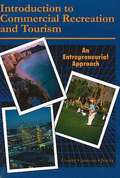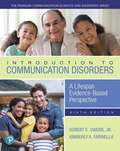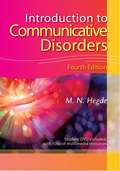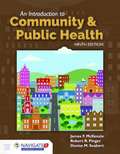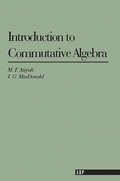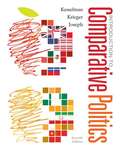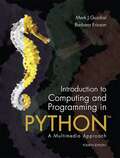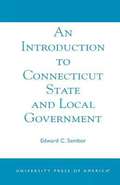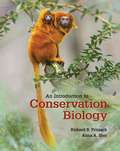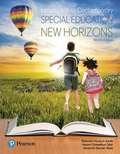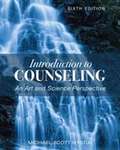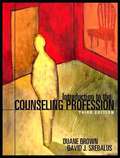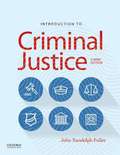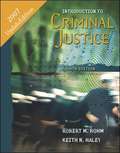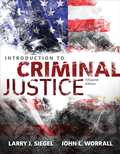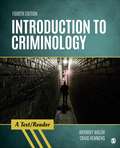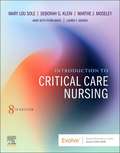- Table View
- List View
Introduction to Commercial Recreation and Tourism: An Entrepreneurial Approach (5th edition)
by John C. Crossley Lynn M. Jamieson Russell E. BrayleyIntroduction to Commercial Recreation and Tourism is a stepping stone to understanding the scope, characteristics, entrepreneurial strategies and management aspects of commercial recreation and tourism. Topics include the history of commercial recreation, definitions, economic applications, business start-up strategies, financing, marketing, operations management, and global trends. This edition also examines industry profiles for the travel, hospitality, and local commercial recreation industries. The Journal of Park and Recreation Administration viewed the past edition as a 'valuable addition to commercial recreation literature'.
Introduction to Communication Disorders: A Lifespan Evidence-Based Perspective
by Robert E. Owens Kimberly A. Farinella Dale Evan MetzA clear, comprehensive introduction to communication sciences and disorders Introduction to Communication Disorders: A Lifespan Evidence-Based Perspective presents recent advances in the assessment and treatment of communication disorders in a highly readable manner. Each chapter is concise, yet comprehensive-striking a just right balance of information appropriate for introductory-level students. Readers gain a basic foundation in the areas of anatomy and physiology of speech and hearing, and an overview of the various disorders that affect voice, fluency, articulation, language, cognition, swallowing, and hearing across the lifespan. Updated case studies, evidence-based practice summary boxes, and new medically based photographs help students bridge the gap between theory and clinical application.
Introduction to Communicative Disorders (4th edition)
by M. N. HegdeIn this update of the 2001, 1995, and 1991 editions, Hegde (communication sciences and disorders, California State U. , Fresno) introduces the rapidly growing science of communication and profession of communicative disorders. Coverage includes a new chapter on literacy skills in children and the role of the speech-language pathologist in literacy intervention; profiles of speech-language pathologists and audiologists; and expanded material on audiology, audiology rehabilitation, and disorders of swallowing. The text includes study questions; information on professional education, organizations, and standards; a glossary.
An Introduction To Community And Public Health
by James F. McKenzie Robert R. Pinger Denise SeabertAn Introduction to Community & Public Health, Ninth Edition provides learners with the latest trends and statistics in this evolving field. With an emphasis on developing the knowledge and skills necessary for a career in health education and health promotion, this best-selling introductory text covers such topics as epidemiology, community organizations, program planning, minority health, mental health, environmental health, drug use and abuse, safety, and occupational health. A robust pedagogy and enhanced digital learning component encourages students to understand and retain community health issues and better prepare for their future careers.
Introduction To Commutative Algebra
by Michael Atiyah I. G. MacdonaldThis book grew out of a course of lectures given to third year undergraduates at Oxford University and it has the modest aim of producing a rapid introduction to the subject. It is designed to be read by students who have had a first elementary course in general algebra. On the other hand, it is not intended as a substitute for the more voluminous tracts such as Zariski-Samuel or Bourbaki. We have concentrated on certain central topics, and large areas, such as field theory, are not touched. In content we cover rather more ground than Northcott and our treatment is substantially different in that, following the modern trend, we put more emphasis on modules and localization.
Introduction to Comparative Politics: Political Challenges and Changing Agendas, AP* Edition
by Mark Kesselman Joel Krieger William A. JosephNIMAC-sourced textbook
Introduction to Comparative Politics: Political Challenges and Changing Agendas
by Mark Kesselman Joel Krieger William A. Joseph"Introduction to Comparative Politics offers accessible material for an introductory comparative politics course. Edited by a highly respected team of scholars, each of the text' s twelve country studies is written by an expert in the field. Four innovative themes, each with a specific focus, form the framework of the text: "The World of States, "Governing the Economy, "The Democratic Idea, and "The Politics of Collective Identities. A classification system focuses on levels of democracy, including established, transitional, and non-democracies. A chapter on the United States follows the same lines of comparison as those on other countries. Every chapter includes four to six sidebars, which focus on different subjects, including leaders, citizen action, institutional intricacies, current challenges, and global connections.
Introduction to Comparative Politics: Political Challenges and Changing Agendas
by Mark Kesselman Joel Krieger William A. JosephNIMAC-sourced textbook
An Introduction to Compressive Sensing
by Wotao Yin Mona Sheikh Jason LaskaIntroduction to compressive sensing. This course introduces the basic concepts in compressive sensing. We overview the concepts of sparsity, compressibility, and transform coding. We then review applications of sparsity in several signal processing problems such as sparse recovery, model selection, data coding, and error correction. We overview the key results in these fields, focusing primarily on both theory and algorithms for sparse recovery. We also discuss applications of compressive sensing in communications, biosensing, medical imaging, and sensor networks.
Introduction to Computer Security
by Michael T. Goodrich Roberto TamassiaThis book is intended to provide an introduction to general principles of computer security from an applied viewpoint, common cyberattacks, including viruses, worms, password crackers, keystroke loggers, denial-of-service, DNS cache poisoning, port scanning, spoofing, and phishing.
Introduction to Computers and Information Technology
by Pearson Learning Solutions StaffIntroduction to Computers and Information Technology teaches essential computer technology concepts and skills. This text helps student build a concrete understanding of how computers work and how various types of computing devices and accessories are used in school, work, and at home. The book consists of three principle sections: Computing Fundamental explores hardware and software basics, input and output devices, storage, and operating systems. Applications teaches introductory skills in word processing, spreadsheets, database, presentation programs, and mutlimedia. Communications and Networks covers the latest in communications devices including smart phones and personal digital assistants as well as the network technology they run on.
Introduction to Computing and Programming In Python: A Multimedia Approach
by Mark Guzdial Barbara EricsonThis book is a uniquely researched and up-to-date volume that is widely recognized for its successful introduction to the subject of Media Computation. Emphasizing creativity, classroom interaction, and in-class programming examples, the book takes a bold and unique approach to computation that engages students and applies the subject matter to the relevancy of digital media. <p><p> The Fourth Edition teaches students to program in an effort to communicate via social computing outlets, providing a unique approach that serves the interests of a broad range of students. Key Topics: Introduction to Computer Science and Media Computation; Introduction to Programming; Creating and Modifying Text; Modifying Pictures Using Loops; Picture Techniques with Selection; Modifying Pixels by Position; Modifying Sounds Using Loops; Modifying Samples in a Range; Making Sounds by Combining Pieces; Building Bigger Programs; Manipulating Text with Methods and Files; Advanced Text Techniques: Web and Information; Making Text for the Web; Creating and Modifying Movies; Speed; Functional Programming; Object Oriented Programming. <p><p> This book is useful for anyone interested in learning computer programming.
An Introduction to Connecticut State and Local Government
by Edward C. SemborThis is a comprehensive text for political science courses focused on state and local government.Included are discussions on the governor, General Assembly, the judicial branch, political parties, interest groups and elections.
An Introduction to Conservation Biology
by Richard Primack Anna Sher<p>This is a book well suited for a wide range of undergraduate courses, as both a primary text for conservation biology courses and a supplement for ecological and environmental science courses. <p>New coauthor Anna Sher joins longtime Sinauer author Richard Primack in creating a book that combines the readability of Primack's A Primer of Conservation Biology with the depth and coverage of his larger textbook, Essentials of Conservation Biology. The result is a book well suited for a wide range of undergraduate courses, as both a primary text for conservation biology courses and a supplement for ecological and environmental science courses. <p>Using the chapter framework of the current Primer as a springboard, the authors have added three chapters focused on population biology conservation tools (Chapter 7), restoration ecology (Chapter 10), and the future of conservation (Chapter 12). Sustainable development, ex situ conservation, and other key topics have been expanded and updated with hundreds of new examples, explanations, citations, and figures to enhance learning and excitement for the subject. Dr. Sher has mined her experience of having taught conservation biology using Dr. Primack's texts for over a decade to fine-tune the presentation of difficult concepts, particularly in economics and politics. Coverage of recent conservation biology events in the news—such as the poaching of Cecil the Lion, the first papal encyclical on the environment, and the international Paris Accord on climate change—keeps the content fresh and current.</p>
Introduction to Contemporary Special Education: New Horizons
by Deborah Smith Naomi Tyler Kimberly SkowIntroduction to Contemporary Special Education: New Horizons presents an introduction to the professional practices, trends, and research that define contemporary special education while also conveying the diversity and excitement of this changing field.
Introduction to Contracts, Sales and Product Liability
by Don Mayer Daniel M. Warner George J. Siedel Jethro K. LiebermanMayer, Warner, Siedel and Lieberman's Introduction to Contracts, Sales and Product Liability is an up-to-date textbook that includes legal issues that are covered in an introductory business law course. The text is organized to permit instructors to tailor the materials to their particular approach. The authors take special care to engage students by relating law to everyday events with their clear, concise and readable style.
Introduction to Cosmology
by Barbara RydenThis second edition of Introduction to Cosmology is an exciting update of an award-winning textbook. It is aimed primarily at advanced undergraduate students in physics and astronomy, but is also useful as a supplementary text at higher levels. It explains modern cosmological concepts, such as dark energy, in the context of the Big Bang theory. Its clear, lucid writing style, with a wealth of useful everyday analogies, makes it exceptionally engaging. Emphasis is placed on the links between theoretical concepts of cosmology and the observable properties of the universe, building deeper physical insights in the reader. The second edition includes recent observational results, fuller descriptions of special and general relativity, expanded discussions of dark energy, and a new chapter on baryonic matter that makes up stars and galaxies. It is an ideal textbook for the era of precision cosmology in the accelerating universe. Written in an engaging style, using clear explanations and analogies to help students connect cosmology to everyday life Fits well to introductory cosmology courses, without requiring advanced mathematics or any prior study of astronomy Includes creative end-of-chapter problems that have been class-tested on students, with an instructor's manual featuring solutions available via www.cambridge.org/cosmology
Introduction To Counseling: An Art And Science Perspective
by Michael NystulIntroduction to Counseling: An Art and Science Perspective provides students with an accessible overview of the counseling profession and also demonstrates how fundamental counseling concepts can be employed to successfully address everyday life challenges. The book posits that counseling is both an art and a science, highlighting the balance between the subjective and objective dimensions of counseling. <p><p> The first part of the book offers students an introduction to the counseling profession and the counseling process, introducing them to conceptual models for counseling, legal and ethical issues, and assessment, research, and evaluation. The second part of the text provides information on multicultural counseling and counseling theories, emphasizing models that are inclusive and adaptive. The final part of the text identifies special approaches and modalities that are helpful in the treatment of diverse populations in particular settings, including children and adolescents in school settings, individuals with mental health issues in hospitals, clinics, and private practices, and more. <p> The sixth edition of Introduction to Counseling features increased focus on professional identity of counselors, content on wellness and positive psychology, increased focus and awareness of social justice issues and advocacy as important dimensions of multicultural counseling, new information on technology-assisted methods of counseling, increased focus on the role of neuroscience in counseling, updated information on the changes in ethical codes, and new guidelines for diagnosis in DSM-5. Presenting timely and critical information in an approachable way, the text is a valuable resource for undergraduate and graduate-level students pursuing helping professions.
Introduction To The Counseling Profession
by Duane Brown David J. SrebalusThe text is designed for use with beginning counselors-in-training who need a straightforward discussion of the history, strengths, limitations, theories, and techniques of the profession. The book includes chapter overviews, chapter summaries, and review questions to assist students in mastering material. Chapters read easily without overreferencing or the inclusion of esoteric material. Because of its size and breadth of overview, an instructor can use supplemental texts to bring emphasis to subjects of special interest.
Introduction To Criminal Justice: A Brief Edition
by John Randolph FullerIntroduction to Criminal Justice: A Brief Edition provides students with coverage of core concepts supported by student-tested pedagogical tools that promote student engagement, thought-provoking classroom discussions, and critical-thinking skills.
Introduction to Criminal Justice (4th Edition Update)
by Robert M. Bohm Keith N. HaleyIntroduction to Criminal Justice, Fourth Edition update is not just for students interested in pursuing a career in criminal justice. It is also for students who simply want to learn more about this important social institution, which is vital to a free and democratic society. All citizens need to know their legal rights and responsibilities.
Introduction to Criminal Justice, Fifteenth Edition
by Larry J. Siegel John L. WorrallINTRODUCTION TO CRIMINAL JUSTICE, Fifteenth Edition, gives readers an exciting behind-the-scenes look at the workings of the police, courts, and correctional systems while equipping them with a solid understanding of criminal justice concepts. With its objective presentation and to-the-point writing style, the text effectively guides readers through the intricate workings of the processes of justice as well as key policy issues. The book also includes an emphasis on today's criminal justice careers, offering insights from numerous professionals on the rewards and realities of their jobs.
Introduction to Criminology: A Text/Reader
by Craig Hemmens Anthony WalshIntroduction to Criminology: A Text/Reader, Fourth Edition offers students a unique, comprehensive, interdisciplinary introduction to the study of criminology. Anthony Walsh and Craig Hemmens provide the best of both worlds—a brief, authored text with carefully selected and edited accompanying readings. Covering both classic and contemporary research in criminology, each reading shows students how to use current research to better understand criminal behavior. Students also gain an interdisciplinary perspective of crime and criminality by exploring the latest theories, concepts, and research from sociology, psychology, genetics, evolutionary biology, and the neurosciences.
Introduction To Critical Care Nursing
by Mary Lou Sole Deborah Goldenberg Klein Marthe J. MoseleyStart here to master the concepts, technology, and procedures of critical care nursing! Introduction to Critical Care Nursing, 8th Edition prepares you to provide safe, effective, patient-centered care in a variety of high-acuity, progressive, and critical care settings. Evidence-based coverage includes realistic case studies and incorporates the latest advances in critical care. Disorders are conveniently organized by body system or special situation, and nursing management chapters include quick-reference nursing care plans. This clear, concise textbook will help you develop the knowledge and clinical reasoning skills needed for success in today's highly complex critical care environments.
